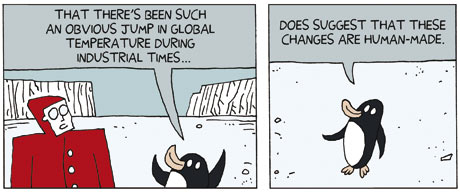
"The argument for human-driven climate change is as follows…" says the talking penguin to the man in the red jacket in the middle of the Arctic ice field. If this sounds like the beginning of a joke, hold on for the punchline.
The quantity of greenhouse gases in the atmosphere has increased sharply since the industrial revolution, the penguin goes on.
"But isn't it true that a growing number of eminent scientists now believe climate change to be wrong?" asks the man. "It's a tiny sliver of fringe opinion," says the penguin, explaining how oil and gas companies are bankrolling climate-change denial while the media supply the doubters with the oxygen of publicity. "The future looks bleak," the penguin concludes.
And the punchline? Drought, hunger, disease and the extinction of a fourth of the world's species, if we don't act soon.
It's a familiar story. What's unusual is the way it's told. Science Tales, in which this conversation appears, deals with some of the most urgent debates in science using pictures, speech bubbles and comic-strip layouts, as well as the penguin.
The man in the red jacket is the cartoon version of the author, Darryl Cunningham, who takes a view on such knotty issues as homeopathy and the MMR vaccine, sorting facts from fiction and presenting complex information in a highly accessible way.
An art-school graduate from Keighley, west Yorkshire, Cunningham dabbled with comics in the early 80s before switching to a career in mental health. He drew on the experience to write Psychiatric Tales (2010). "Each chapter looks at a different psychiatric illness and tries to explain it from the point of view of the sufferer and then looks at the biology of it. At the end, I wrap it up with my experience of depression and what that was like."
The new book begins on similar ground with a chapter on electroconvulsive therapy, before broadening out to tackle everything from evolution to moon landing conspiracy theories. He doesn't claim to be an expert but he brings extensive research, as the list of sources demonstrates, and no small amount of passion to the subject.
What compelled him to write it? "It was the amount of disinformation and anti-science stuff around," he tells me. The danger with alternative therapies such as homeopathy is "apart from the fact that you spend a lot of money on them, they could delay you from getting real treatment for something such as cancer where a week or a month could mean the difference between life and death".
There is a prejudice, usually held by people who haven't read one, that the graphic format is unsuited to tackling weighty subjects, but the form abounds with examples to the contrary: see Joe Sacco's pictorial reports from conflicts in Bosnia and Palestine or David B's unbearably moving account of a family illness in Epileptic. Far from being a frivolous medium, the graphic book is a great way of getting to grips with serious issues, Cunningham says. "It summarises things very quickly and you can plough through a lot of information. I love the simplicity of it."
There are downsides, he admits: "You can't go into massive detail, but in the end it's for a general reader so I'm not going to go too much into the nuts and bolts."
When scientists publish research, it is subjected to peer review, in which other scientists in the field put their methods and conclusions to the test. Cunningham put his work through a kind of peer-review process of his own. Each time he completed a chapter, he put it up on his blog so online readers could tell him what they made of it.
"The evolution chapter generated the most comments. I had people chipping in telling me, 'You've got that wrong', so I was able to make corrections for the published version. It was very useful feedback for me."
Not all criticism was constructive. "The alternative therapies chapters upset people the most, while some people were not happy with me because of the moon hoax chapter. But the responses that really made me think were about climate change. I had to step back and think about that, because the science is so complex."
He has done a good job of representing the subject in all its ambiguities, but ultimately it is a snapshot of how we understand climate change at this time. As new information emerges, that understanding will be expanded and refined. As his Afterword says: "Good science is testable, reproducible and stands the test of time. What doesn't work in science falls away and what remains is the truth."

